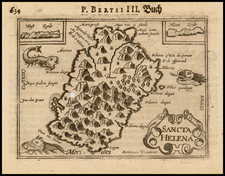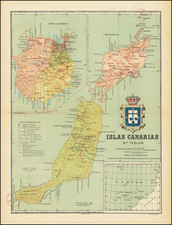Rare English Edition!
Striking set of three views of St. Helena, engraved for the English edition of Baptista van Doeticum for Linschoten's Itinerario, Iohn Huighen van Linschoten. His discours of voyages . . . , published in London in 1598, and engraved by English engraver Raygnald Elstrak.
A richly ornamented view of the Island of Saint Helena, the half way point across the Atlantic Ocean between Africa and South America.
St. Helena was discovered on May 21, 1502 by the Portuguese navigator João da Nova, on his voyage home from India. The Island is named after Helena of Constantinople. While popular myth holds that the Portuguese kept the location a secret until almost the end of the 16th century, both the was described as early as 1508 in a Dutch book that described a 1505 Portuguese expedition led by Francisco de Almeida from the East Indies. Lopo Homem-Reineis published the " Atlas Universal" about 1519 which showed the locations of both St Helena and Ascension.
Sometime before 1557, two slaves from Mozambique, one from Java, and two women, escaped from a ship and remained hidden on the island for many years, long enough for their numbers to rise to twenty. Bermudez, the Patriarch of Abyssinia landed at St Helena in 1557 on a voyage to Portugal, remaining on the island for a year. Three Japanese ambassadors on an embassy to the Pope also visited St Helena in 1583. Sir Francis Drake may also have located the island, which is believed to be how the location of the island was known to the English only a few years later, Thomas Cavendish arrived on the island in 1588, during his first attempt to circumnavigate the world and stayed for 12 days. Another English seaman, Captain Abraham Kendall, visited Saint Helena in 1591, and in 1593 Sir James Lancaster stopped at the island on his way home from the East.
Once St Helena's location was more widely known, English ships of war began to lie in wait in the area to attack Portuguese India carracks on their way home. As a result, in 1592 Philip II of Spain and I of Portugal (1527-1598) ordered the annual fleet returning from Goa on no account to touch at St Helena. Over time, St. Helena became less important to the Portuguese and increasingly important to the Dutch, who finally claimed the island in 1633.
Wolfe, Linschoten, and the Itinerario
In 1594, Linschoten set out with Willem Barentsz on an exploratory expedition to find the Northeast Passage. The crew had many adventures, including an encounter with a polar bear, which they killed while attempting to capture it. Eventually, the crews had to turn back because of ice, a situation that also happened with a similar expedition the following year.
Upon his return, Linschoten published his journal from the Barenstz voyages. In 1595, he also published Reysgheschrift vande navigation der Portugaloysers in Orienten (Travel Accounts of Portuguese Navigation in the Orient), based on his research. The work includes sailing directions in addition to descriptions of lands still new to Europeans, like Japan. In 1597, Linschoten published again, this time a description of the African coast.
His most famous work, however, is Itinerario: Voyage ofte schipvaert van Jan Huyghen van Linschoten naer Oost ofte Portugaels Indien, 1579-1592 (Travel account of the voyage of the sailor Jan Huyghen van Linschoten to the Portuguese East India). It was published in 1596 by Cornelis Claesz in Amsterdam.
Two years later, in 1598, John Wolfe published an English translation, with entirely newly maps engraved in London by Robert Beckit, Raygnald Elstrak, William Rogers. The 11 maps includes several maps not drawn from the original Lisnchoten Itinerario, including a World Map after Ortelius, two maps of Africa drawn from Pigafetta, and an English copy of the first state of the Plancius Spice map.
Rarity
The Wolfe edition of Linschoten's work is very rare on the market, as are the individual maps.









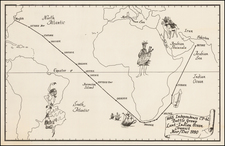
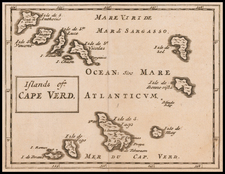
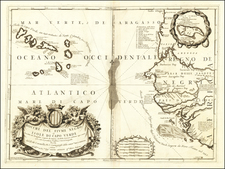
![[ Coast of North America and Mythical Islands in the Atlantic ] and [ Scandinavia, Baltic, etc ]](https://storage.googleapis.com/raremaps/img/small/105724.jpg)
